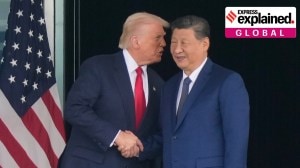The farmer pays the price
One of the most difficult issues to explain to an Indian farmer is the fertiliser conundrum. He feels cheated. Having gone to a village for ...

One of the most difficult issues to explain to an Indian farmer is the fertiliser conundrum. He feels cheated. Having gone to a village for something else, I got trapped in a discussion on fertiliser prices, because the newspaper that day carried a story on the new policy and that a committee I chaired last year decided the capacity levels for the plants.
Try as I would, I couldn’t get through on the fact that we sell fertiliser at less than the world price with transport costs added, and the problem was to free the trade to sell the many new materials available at low cost and to consolidate the industry to produce urea at globally competitive costs, and get out of trying to determine the rest of the game. I thought the new policy was trying to do this, in a time frame which needs to be shortened. I came away, not having convinced anybody.
The last two budgets, the Five Year Plan, the Expenditure Reforms Commission and my committee all want fertiliser price reform. The Planning Commission, interestingly, discusses fertilisers in the chapter on the environment, pointing out that while on an average consumption is less than in neighbouring countries, in some crops and regions, ‘‘continuous use of these chemicals is fraught with danger.’’ All these august bodies are in good company. Seventeen years ago, in 1985, the ministry of finance in its Long Term Fiscal Policy Statement stated ‘‘Fertiliser is an energy intensive industry and studies show that energy consumption per unit of output varies widely among units of the same feedstock. The incentives to economise on energy are also weak in a pricing system where retention prices are determined plant wise.’’ I am quoting this statement, not because it was based on work I had organised in the BICP which proved then that a one per cent improvement in capacity utilisation leads to anywhere between a third of one per cent to two per cent reduction in energy costs, which are the major costs in the industry. But for another reason and that is that seventeen years ago the path of reform was clearly outlined. It is said that our reform is slow and sure. But how slow is slow?
First the facts. The new policy is based on a group pricing policy based on feedstock, although the details are not quite clear. The Hanumantha Rao Committee had also suggested this and this was endorsed by the ERC. But as the published report of the Hanumantha Rao Committee Report explains, in 1983 a committee on fertiliser pricing had set up a group under my chairmanship, with Bimal Jalan and
Vijay Kelkar as members. It recommended: group retention prices for naptha, coal, gas, fuel oil/LSHS; long term marginal prices were attempted for the new gas-based plants and a uniform price for urea may be considered, after first moving over to group retention price to allow plants time
to adjust. We had shown then that costs vary with capacity utilisation, which is a management responsibility. So good plants would reorganise and compete and bad ones
and those who won’t adjust would go to the wall. India had the capability to produce fertiliser in a competitive sequence and reform should consolidate that capability. Seventeen years later we say the same thing.
Why did fertiliser miss the bus in the first round of reform in the mid- eighties? It is not that the knowledge was not there. The laboured arguments in the last two paras shows that Bimal Jalan, Vijay Kelkar and I had produced the counterfactual. This was a period in which around two thirds of Indian industry had been decontrolled in a phased manner. Fertiliser missed the bus for three reasons. The inefficient producers, who would not adjust were politically powerful enough to scuttle the reform. A unit level pricing system gives them the scope to fix outcomes in their favour. A group level system breaks the nexus between the price fixing babu and the sheth, on a one to one basis. After the adjustment you would have to compete with the world and who wants to do that, even if you can. Two, netas wanted to tell the farmer that they fight the robber barons in their interest. In fact, the politicians didn’t do anything of the sort and in the two decades that they delayed reform, the farmer and the taxpayer paid for their posturing.
I have a feeling that the eleven farmers I talked with in a Gujarat village, at least understood this and also that they were being taken on a ride on some other more important issues also. The third reason is that nobody feels obliged to justify the details of the reform they talk about and we let them do it. I was told that long range marginal price means a very high price. This is not true. It is not always the cost of the most expensive unit. It is the cost of the most efficient man who will produce extra output. He may use more capital, but he will have lower input costs and his costs you have to pay, for there are no free lunches. And don’t listen to the guy who promises you that free lunch, for he is a liar.



- 01
- 02
- 03
- 04
- 05




























